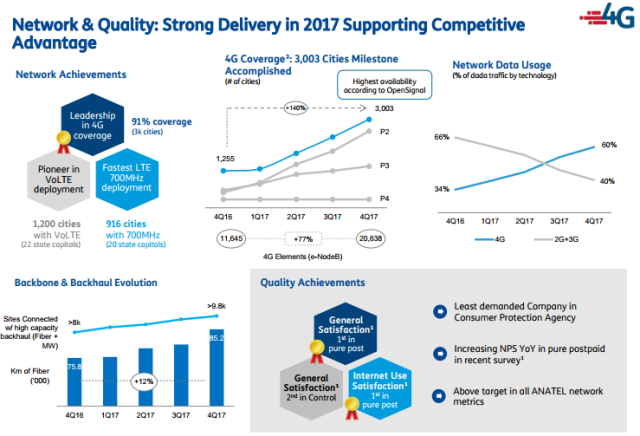
TIM Brazil has revealed its update on digital transformation and growth in revenue, Opex and Capex related investment in the fourth quarter of 2017.
TIM Brazil posted revenues of R$ 4,257 million (+5.3 percent) in Q4 and R$ 16,234 million (+3.9 percent) in 2017.
Mobile service revenues of TIM Brazil grew 6.1 percent in the quarter and 5.1 percent in 2017. Fixed service revenues rose 6.1 percent in Q4 and 4.7 percent in 2017.
TIM Brazil’s data and content revenues grew 43.2 percent in Q4, representing 61.5 percent of MSR.
Mobile ARPU of TIM Brazil grew 13.9 percent to R$ 21.9 in Q4 and increased 12.1 percent to R$ 20.2 – driven by the improvement in the base mix (more post-paid).
Costs
TIM Brazil said network and interconnection (ITX) costs grew 8.3 percent due to hike in network elements related expenses, and costs with infrastructure sharing. Network and Interconnection costs rose 1.4 percent.
Q4 EBITDA was R$ 1,769 million (+13.3 percent) with 41.6 percent margin due to increase in mobile service revenues with a higher contribution margin, higher fixed service revenues and cost control. The 2017 EBITDA was R$ 5.9 billion (+13.7 percent) with margin of 36.6 percent.

TIM Brazil reduced Capex to R$ 1,661 million (–2 percent), dedicating approximately 89 percent to infrastructure, mainly transportation network projects, 4G technology, IT and analytics.
TIM Brazil’s investments in 2017 was R$ 4,148 million (–7.9 percent) due to efficiency on investments focusing on coverage, installing more equipment and fiber, using less resources, due to better negotiated conditions.
TIM’s 4G coverage reached 3,003 cities, or 91 percent of the country’s urban population, an increase of approximately 140 percent over 2016. This expansion was due to the increase in 4G sites e-NodeB elements, which grew 77 percent in the year.

TIM followed spectrum refarming strategy. It used 1,800 MHz band and used frequency as per availability, redirecting to new technology from 2G to 4G. This practice permits coverage optimization, using Capex more efficiently.
TIM developed its LTE network using the 700 MHz frequency, operating in 916 cities, of which 20 are capitals. The activation of 4G in the 700 MHz band allows more signal reach with higher download and upload speeds, as well as lower latency. Its VoLTE service is available in 1,200 cities including 22 capitals.
TIM said its own Biosite solution for densification of mobile access network reached a total of 528 active Biosites. The company is also working in fixed wireless broadband technology (Wireless-To-The-X), which enables wireless broadband via the LTE network.
The expansion of this service is leveraged by TIM’s 4G coverage leadership and the use of the 700 MHz band, making it possible for WTTx to be offered in 16 cities by the end of 2017.
The number of 4G users reached 27.6 million (+63.7 percent) — mainly due to the users’ migration of 3G to 4G seeking a better user experience. 3G subscriber base was 19.1 million users (–35.3 percent).
